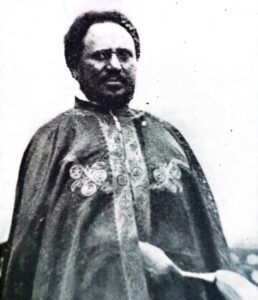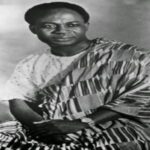SEYUM, MANGASHA
- 3 Min Read
Ras Seyum Mangasha (June 21, 1887-December 15, 1960), son of Ras Mangasha Yohannes and grandson of Emperor Yohannes IV, was one of the most influential Ethiopian nobles of his time, and played a role in national politics throughout the first half of the 20th century.

PHOTO CAPTION: Ras Seyum Mangasha. SOURCE: EA Library
As a Gojam nobleman’s son, he was given the title of Dajazmach at the age of ten. Because of his high rank he was involved in the political turmoil in the country, and was often detained in the capital as a preventive measure against subversion. In 1903 he began his political career by challenging the appointment of Ras Gugsa Wale, governor of Bagemder province. In 1910 he himself was appointed governor of Endarta, and in 1913 was made Ras by Lej Iyasu Mikael, the nominal ruler of Ethiopia from 1903-16, and was also given a greater part of Tegré to rule.
Also in 1913, he tried to resist the appointment of Ras Mikael [Mohammed Ali] as king of Wallo and Tegré. But he was won over by his marriage to Mikael’s daughter, who was the sister of Lej Iyasu. This relationship, however, did not lead him openly to support Lej Iyasu and Ras Mikael. After the deposition in 1916 of Lej Iyasu, Seyum Mangasha in 1917 even paid homage to the new empress, Zawditu [reigned 1917-30]. He was afterwards detained in the capital, but was later reinstated as governor of Tegré, from where he was summoned in 1920 to answer a charge of harbouring the fugitive Lej Iyasu.
He stayed in the capital, and in 1924 even accompanied the Regent Ras Tafari, later to become Emperor Haile Selassie [reigned 1930-74] on his first European tour. He was sent back to Tegré on the return of the imperial party, and proved loyal during the turbulent year of 1930, when Ras Gugsa Wale rebelled in Bagemder. In the same year he was made Leul-Ras, and in 1931 he was appointed to the senate of the first Ethiopian parliament.
When the Italians invaded Ethiopia in 1935, Seyum was appointed commander of the Tegré troops, but his failure as a guerrilla fighter led to an Ethiopian defeat at the second battle of Tamben. He nevertheless fought beside the emperor at the battle of Maychaw in 1936, at which the Ethiopians were again defeated. After this, he retreated to Tegré, and surrendered to the Italians, who kept him in Italy until the end of 1938, when they returned him to Ethiopia as a gesture of pacification.
In 1941, when Ethiopia was liberated, he received and acknowledged Emperor Haile Selassie. But his pro-Italian attitude during the war made him suspect, and he was sent back to Tegré only in 1947. He remained as governor of Tegré until 1960, when he was killed during the attempted coup against the imperial government. His political and private lives were influenced largely by family rivalries. From his earliest days in Tegré he had rivals in Ras Gugsa Areyea, and Ras Gabra Selasse Barya.
In 1917 he was reconciled, through the intervention of the Crown Council, to Gabra Selasse, who married his daughter. Moreover, in spite of the rebellion in Tegré against the central government, Seyum remained staunchly loyal to it, and even punished his own son when he tried to rebel.
TSEHAI BERHANE SELASSIE



